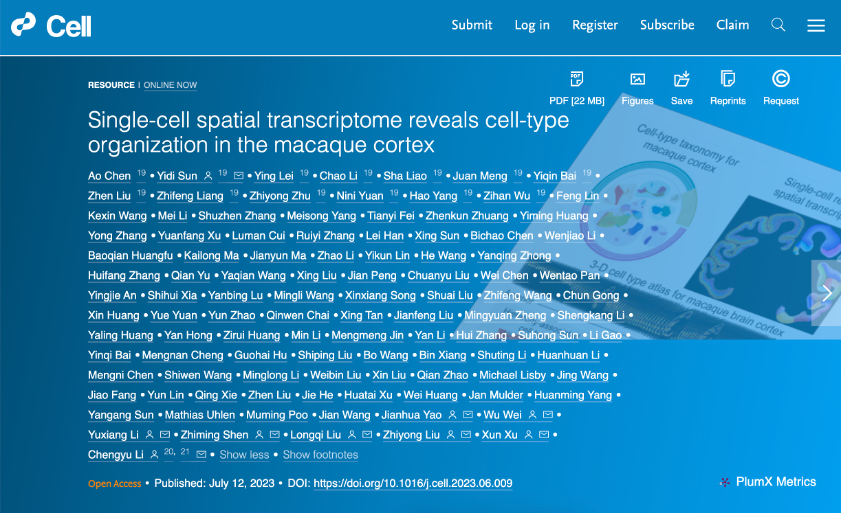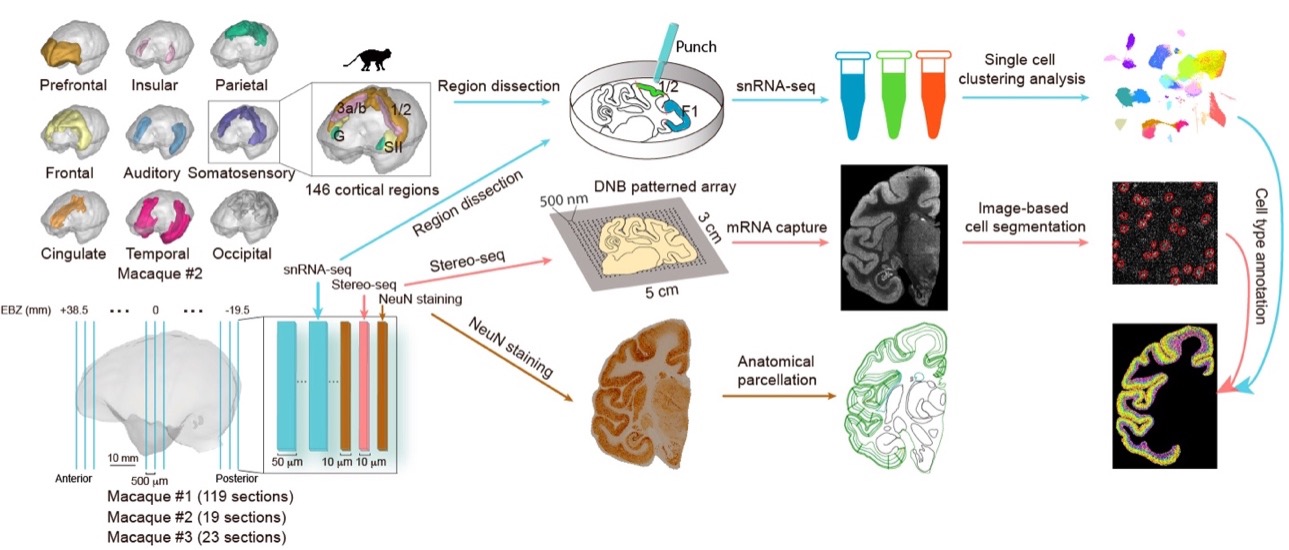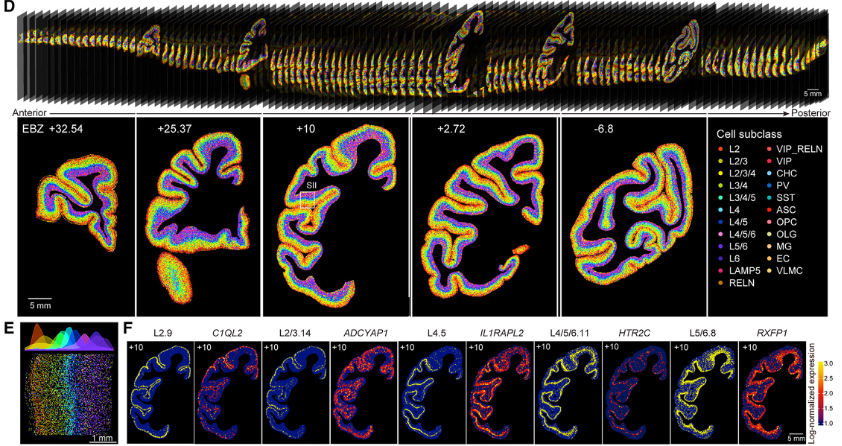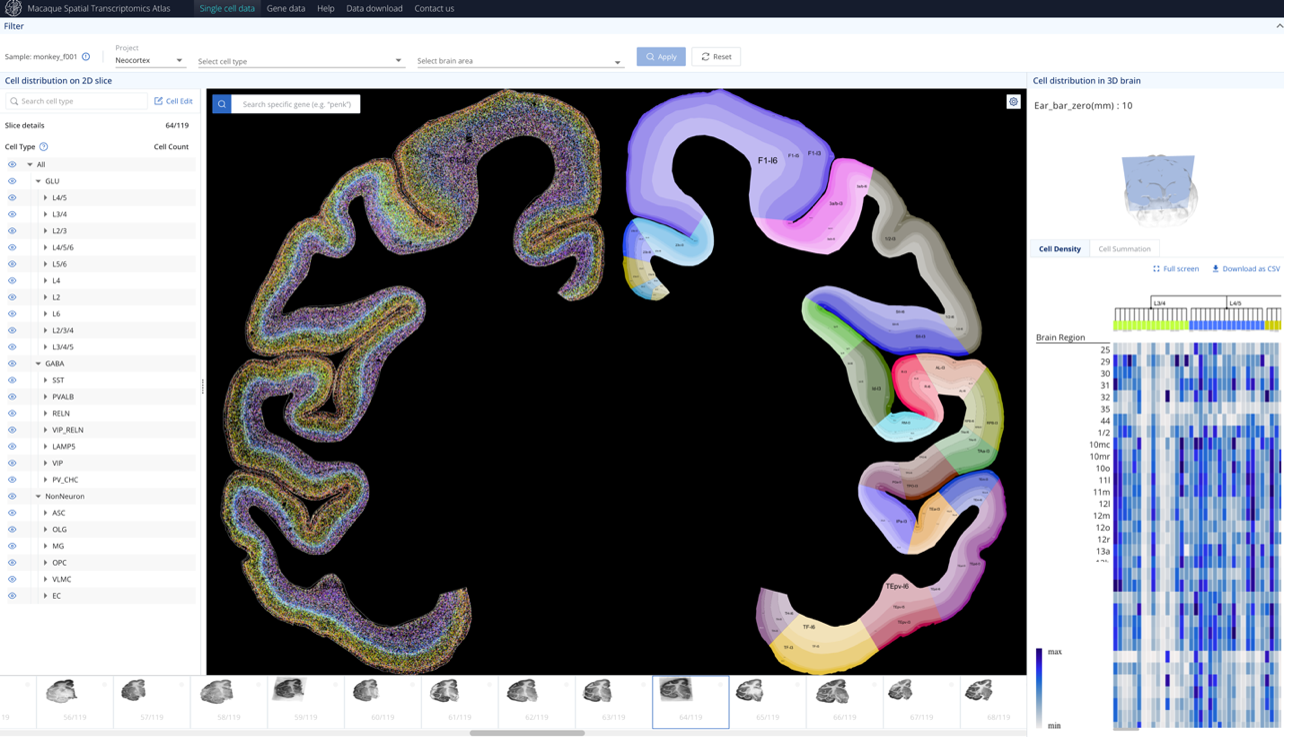All
Products
Resources
News
FAQ
Search
12/07/2023
International scientists from China and other countries on July 12 released the most complete primate brain cell atlas so far, setting a new milestone for the development of brain science and providing a new foundation for the research of brain diseases such as Alzheimer's and Parkinson's. Their research paper was published in Cell.

The research paper “Single-cell spatial transcriptome reveals cell-type organization in macaque cortex” was published in Cell.
Using spatio-temporal omics technology and single-cell sequencing technology developed by BGI Group, the research teams from the Center for Excellence in Brain Science and Intelligent Technology (Institute of Neuroscience) of the Chinese Academy of Sciences, BGI-Research, and other institutions defined the most comprehensive primate cerebral cortex cell types and their molecular characteristics to date, and explored the spatial distribution of diverse cell types in the macaque cortex.
Using this atlas, the scientists were able to understand which cell types are present in the macaque cerebral cortex and where these cell types are located. As the most complete "instruction manual" for primate brain cells, this study provides a reference for basic knowledge in the fields of brain science, such as human brain functions, brain diseases, and brain-computer interfaces, and will greatly accelerate the progress of brain science research.
Stereo-seq, BGI’s spatio-temporal multi-omics technology used in this study, has a nanoscale resolution that is about 200 times of the iPhone 14 Pro camera. It also has a large field of view. Stereo-seq not only solves the problems of low resolution and inability to achieve single-cell resolution of similar technologies in the world, but also solves the problems of small field of view and inability to conduct research on larger tissues.
The macaque is the closest evolutionary model animal to humans, with a brain containing more than six billion cells. In this study, the research team used Stereo-seq technology to collect spatial transcriptome data of 161 macaque brain slices with a thickness of 10 microns. Combining with large-scale single-nucleus sequencing technology DNBelab C4 snRNA-seq, another technology independently developed by BGI, the scientists obtained single-cell transcriptome data from millions of cortical cells in the macaque cerebral cortex.
Through joint analysis of the gene expression and spatial information of individual cells in 143 brain regions of the macaque cerebral cortex, the research team drew the world's first three-dimensional single-cell atlas of the whole brain cortex of crab-eating macaque, and constructed a three-level taxonomy tree that reveals the relationship between different types of cells and the hierarchical structure of the brain’s regions.
 Overall experimental design.
Overall experimental design.
Breakthrough Technology Supports Brain Science Research Discoveries
"The cell composition of the brain and its spatial distribution are the basic issues of brain science, and its importance is similar to the DNA base sequence discovered by human genome sequencing," said Dr. LI Chengyu, co-corresponding author of the article and a researcher at the Center for Excellence in Brain Science and Intelligent Technology of the Chinese Academy of Sciences.
"The cerebral cortex organization of macaques is similar to that of humans in many aspects. This study provides the most complete primate brain data for the systematic analysis of cell type-specific and region-specific distributions in the cortex, as well as gene expression characteristics,” he added.
The chip used in this technology is a DNA nanoball chip with spatial position information and array arrangement independently developed by BGI, based on its own DNBSEQ sequencing technology, which improves the resolution to the subcellular level of 500 nanometers. At the same time, in this study of macaque brain cells, the research team made a breakthrough by using 6 cm x 5 cm and 5 cm x 3 cm large field-of-view chips, thus realizing the construction of a panoramic molecular atlas of the macaque brain cerebral cortex.
"The resolution of Stereo-seq technology is very high, which is a great advantage. It can really locate the specific spatial position of each cell and can define each cell type and its molecular characteristic," said Dr. LEI Ying, co-first author, Chief Scientist and Associate Researcher at BGI-Research. "At the same time, it also has the advantage of having a large field of view, which was not possible before. Therefore, it is very suitable to use this technology for macaque brain research. It is also the largest field of view for the application of spatial omics technology in research."

Spatial distribution map of cell types in the macaque cortex.
Revealing the Distribution of Neurons in the Primate Brain
Based on the atlas of the cerebral cortex, the research team found that the distribution of a large number of excitatory neurons, inhibitory neurons and non-neuronal cells in the brain of macaques in the cerebral cortex showed obvious specificity of each level and each brain region. Based on this, the research team took the visual system and the somatosensory system as examples to carry out further research and found that there is a significant correlation between the cell type composition of the two systems and the hierarchical organization of brain regions. Brain regions at the same level often have similar cell type composition, revealing the relationship between cellular composition and structure of brain regions.
In addition, through cross-species comparison with published single-cell data of human brain and mouse brain, the research team also found glutamatergic neuron cells specific to primates, and highly expressed genes related to human diseases, including the FOXP2, DCC, EPHA3, etc.
"The constructing of the macaque brain cell atlas will help us better understand brain diseases and provide basic reference resources for future design of disease treatment targets," said Dr. XU Xun, co-corresponding author of the article and Director of BGI-Research. "At the same time, it is also expected to promote breakthroughs in the field of brain science, such as in brain-inspired intelligence and brain-computer interfaces, through more accurate EEG signal collection, to achieve more complex body activities. These are development directions worth looking forward to and need scientists globally to jointly explore.”
This research is a collaboration of nearly 100 interdisciplinary and cross-field researchers from several institutions, relying on independently developed core technology and a large platform, under the guidance of clear goals and tasks, with the division of labor and complementary, efficient collaboration. The research has passed the ethical review and strictly followed the corresponding regulations and ethical guidelines.
This year marks the 20th anniversary of the completion of the Human Genome Project (HGP), a milestone event in the history of life sciences. This research is also the inheritance and continuation of the spirit of "Owned by All, Done by All, and Shared by All" proposed by Chinese scientists during the Human Genome Project.
In the future, the research team will continue to tackle key problems in the fields of brain disease mechanism and target research and development, brain cell and brain structure evolution, and cellular and molecular mechanisms of brain function, so as to continue to produce original and leading achievements in related fields.
The research produced the world's first relatively complete set of single-cell and spatial transcriptome data of the macaque whole brain cortex, and the data repository has now been shared publicly (https://macaque.digital-brain.cn/spatial-omics). The research paper entitled "Single-cell spatial transcriptome reveals cell-type organization in macaque cortex" has been published online in the journal Cell.

Database of cell types and gene expression in the macaque cortex.
Dr. LI Chengyu, Dr. LIU Zhiyong, Dr. SUN Yidi, Dr. SHEN Zhiming from the Institute of Neuroscience, Center for Excellence in Brain Science and Intelligence Technology of the Chinese Academy of Sciences, along with Dr. XU Xun, Dr. LIU Longqi, Dr. LI Yuxiang from BGI-Research, and Dr. WEI Wu from Lingang Laboratory, as well as Dr. YAO Jianhua, AI Healthcare Chief Scientist of Tencent AI Lab, are the co-corresponding authors of the paper. Dr. CHEN Ao and Dr. LEI Ying from BGI-Research, Dr. LIAO Sha, Mr. ZHU Zhiyong (Master's student), Dr. SUN Yidi, Dr. LI Chao, Dr. MENG Juan (PhD student), Dr. LIANG Zhifeng, Dr. YUAN Nini, and Mr. YANG Hao from the Center for Excellence in Brain Science and Intelligence Technology, along with Dr. BAI Yiqin, a postdoctoral researcher from Lingang Laboratory, Dr. LIU Zhen, a PhD student from Shanghai Institute of Nutrition and Health, Chinese Academy of Sciences, and Mr. WU Zihan, a researcher from Tencent AI Lab, are the co-first authors of the paper. The research was supported by the National Science and Technology Innovation 2030 Major Program, Shanghai Municipal Science and Technology Major Project, and projects from Ministry of Science and Technology, National Natural Science Foundation of China, and Shenzhen Municipal Government.
The Cell research article can be found here:
https://doi.org/10.1016/j.cell.2023.06.009
Source: BGI Group Website